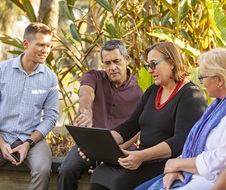New look website to help NSW build climate change resilience
The new look AdaptNSW website went live today to help people prepare and adapt to climate change impacts.

Department of Planning and Environment Executive Director Climate Change and Sustainability, Dr Kate Wilson, said the website is the leading source of credible information on climate change for NSW, including new climate information and resources, risk guides, checklists and inspirational case studies.
"These are designed to help households, community groups, business and government prepare and respond to the very real impacts of climate change," Dr Wilson said.
"Critically, it shows society how it can respond to challenges from droughts and heatwaves to floods and bushfire providing practical material to help us all to be more aware of how climate change will affect day to day life and what we value."
"Local councils and businesses, small and large, can use the information on the AdaptNSW website to identify and manage climate risks and their employees' health and safety."
"With increased frequency and intensity of heatwaves affecting human health, the website's information can minimise these impacts through climate smart design and planning."
Dr Wilson said climate change impacts are incredibly diverse from increasing temperatures that affect our way of life in urban areas to the impacts of flooding on infrastructure.
Executive Director Science, Economics and Insights Division, Dr Georgina Kelly, said: "The website is supported by rigorously produced data from our world class NSW and ACT Regional Climate Modelling (NARCliM). We provide high resolution climate change projections for local decision making, which are available through a range of products on the website.
The website's case studies show how people, communities and businesses are already taking action like farmers adopting digital technology to improve productivity and climate change resilience, and citizen science programs monitoring changes to the NSW coastline.
"NSW's average temperature has already increased by 1.4 degrees since national records began in 1910 showing some climate change is already locked in," Dr Wilson said.
"We're working to manage these impacts, producing hazard maps and reports for key hazards, such as extreme temperature and rainfall, bushfire, drought and heat, to help decision makers understand and better manage risks."
"The NSW Government is committed to making New South Wales more resilient to climate change and reaching net zero emissions by 2050 through the NSW Climate Change Policy Framework."

